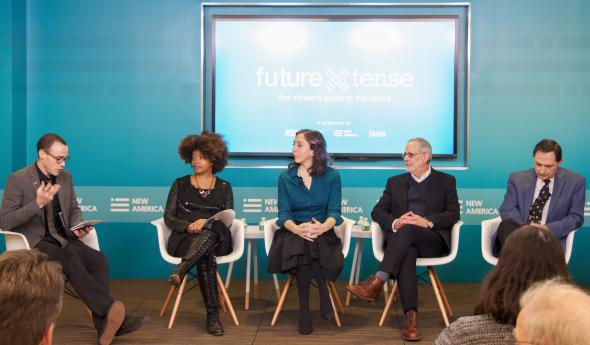While flying cars and colonies on Mars may feel closer than ever, Americans have been aspiring to both for a very long time. But the way we think about the future depends a lot on the present. At a Nov. 14 event called “History of the Future,” Future Tense—a partnership of Slate, New America, and Arizona State University—brought together writers and academics to discuss our relationship with tomorrow, and how it has changed.
“The future, unlike the past and unlike the present, is an invention,” said Neal Gabler, author of Walt Disney: The Triumph of American Imagination. He noted that early societies saw future as “cycles [that] repeated themselves,” but post-Enlightenment scholarship brought us into a more linear way of thinking about the future.
After Gabler’s remarks, speakers offered case studies focused on how transportation, the home, work, and entertainment provide us case studies of America’s long fascination with the future. In a presentation about historical visions for the future of transportation, Joey Eschrich, editor at Arizona State University’s Center for Science and the Imagination, discussed British bureaucrat Ebenezer Howard’s “Garden City” model from 1898. In this scheme, the grit and grime cities like London would be solved by concentric railways that would free up the space in between for healthier, green spaces. The spaces were designed to be walkable and to reduce transportation time to free up life for other pursuits. While Blade Runner-style vehicles might get more attention, designs like Howard’s suggest that what we really want, then and now, is to reclaim the time “lost between the places we want to be, the things we need to do, and the experiences we want to have.”
But according to Reason editor-in-chief Katherine Mangu-Ward, tedium has been an important part of our visions of the future. “What the future of life at home looks like is what life at home has always looked like,” she said. “People have a way of muddling through to a kind of messy human-ish middle ground no matter what resources they’ve been given.” Far from “utopian plenty” or sheer dystopia, we’ve landed in a middle ground where Postmates robots bring us takeout and Roombas vacuum our floors—helpful but not life-changing technologies. According to Mangu-Ward, “ordinariness” has always been essential to our visions of the future.
This may be a result of what television producer Patric Verrone described as the “tech plus one” principle: when futurists take an existing technology and added one dimension. This is especially true when it came to visions of future entertainment, said Verrone. For instance, both Jonathan Swift and Jules Verne described forms of television in their works. Even as recently as 1989, Back to the Future Part II predicted holograms that theatergoers would interact with—something that doesn’t seem so far-fetched given entertainment’s current obsession with virtual reality.
What visionaries didn’t account for was that time-saving technologies have us working more, not just enjoying more leisure time.
“You tend to not have more leisure time but rather try to cram more of those activities into one day,” said author Ytasha Womack. Womack remarked on the accuracy of our predictions for work and our desire to “create some sort of efficiency through communications,” which eventually resulted in technologies like email and video conferencing.
While many of the predictions shown at the event have born into fruition, their visionaries didn’t seem to anticipate many of the consequences.
As seen in the various video montages during the event, past visions of the future left out a significant portion of America. Robot assistants might rid grumpy white, male executives of secretaries, but they did little for the laboring underclass. Dream kitchens filled with automatic cake makers were reserved for white housewives. This future vision of work had labor issues that still persist. Mangu-Ward described the automation trope as a way for science fiction writers to deflect away the real-life problems we face with labor. Newer ways of thinking about the future, like Afrofuturism, can help us correct these limited visions, said Womack.
While the speakers shared varying levels of optimism for our current future, they agreed that we can learn from history’s mistakes by adapting more intersectional frameworks and implementing safeguards against technological change, particularly in regards to labor. Instead of becoming “hopelessly fatalistic,” Future Tense editorial director Andres Martinez urged Washington in particular to “take ownership” of the challenges our future brings.
